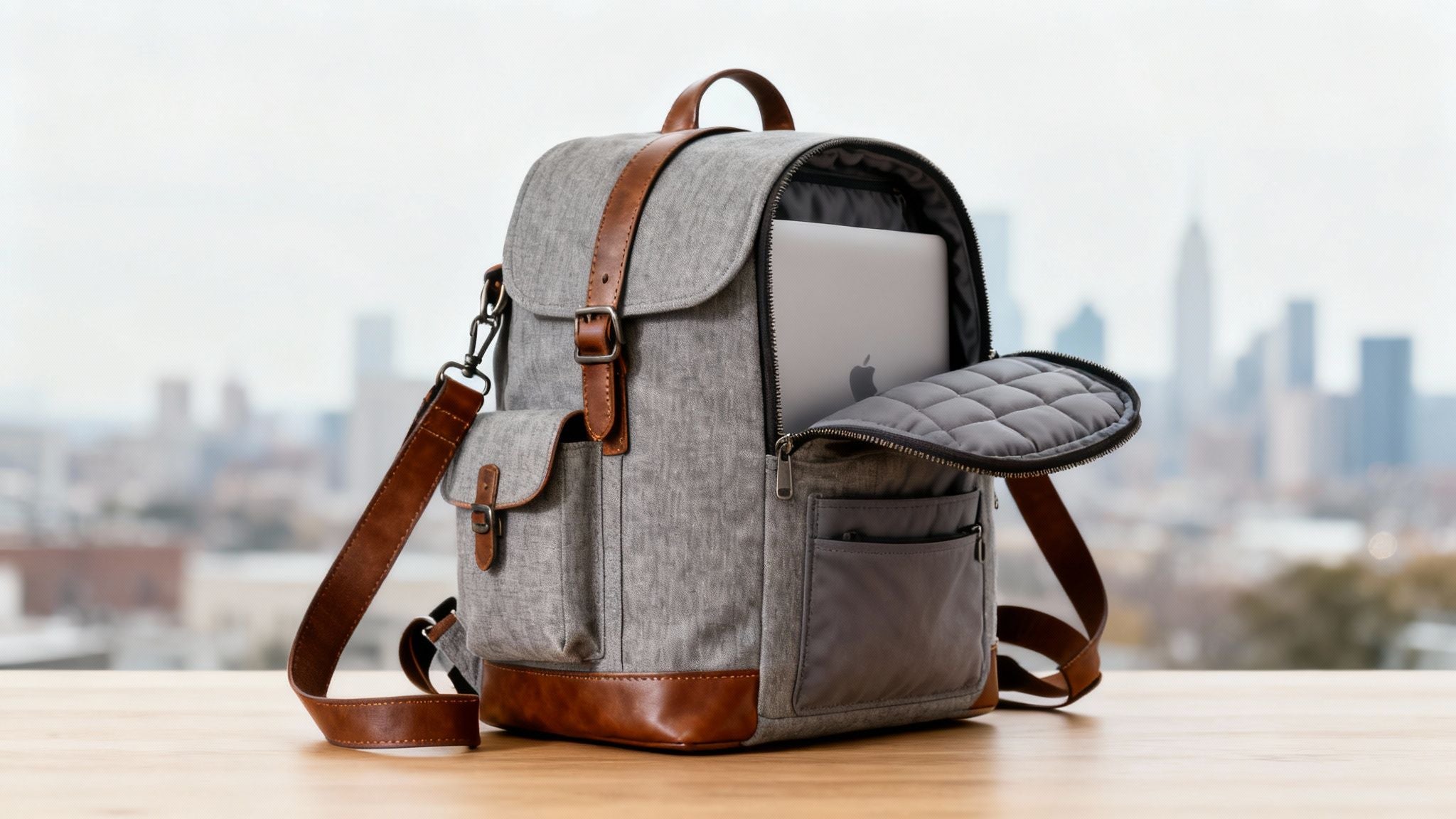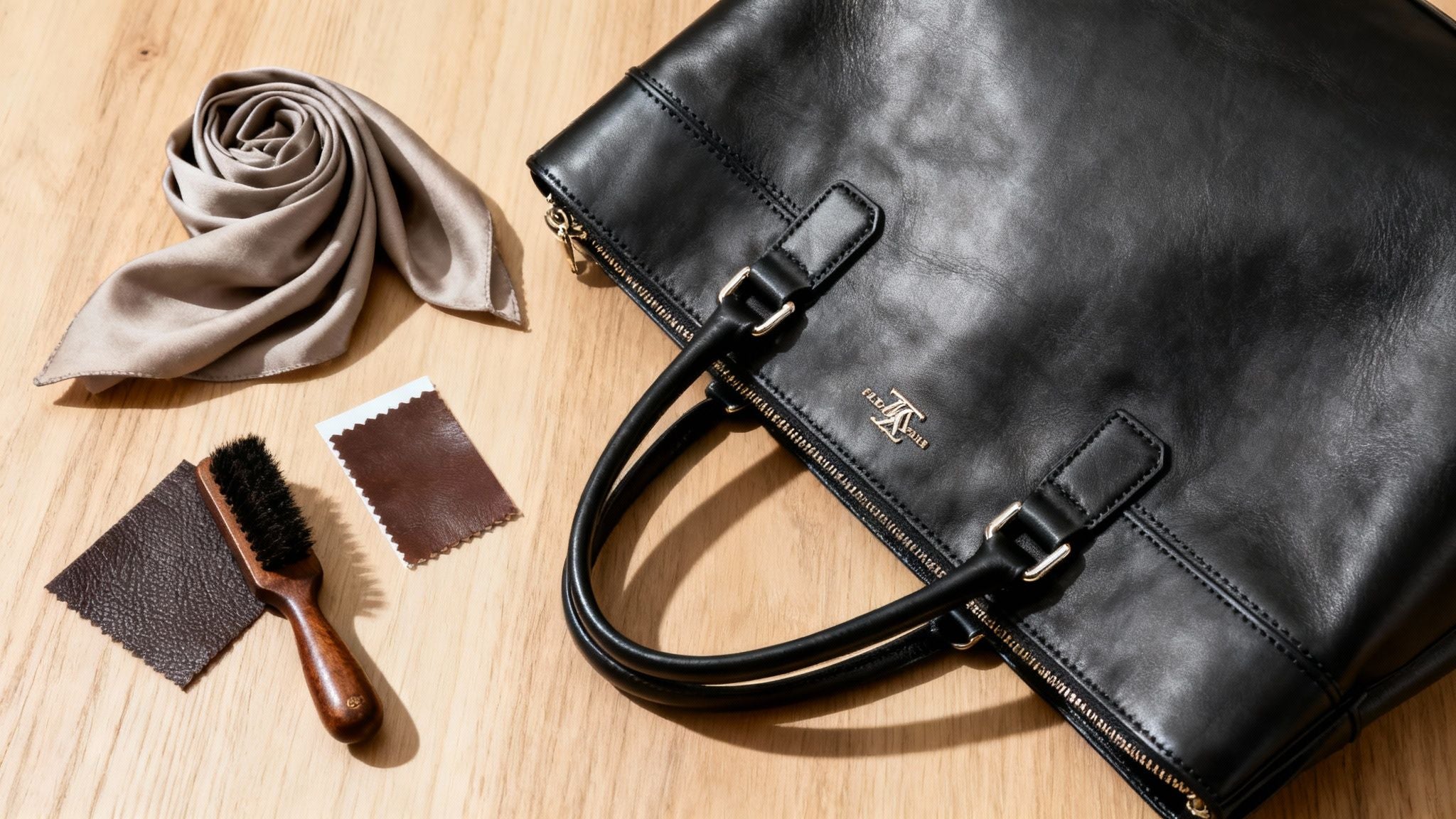A Guide to Real Leather Women's Handbags
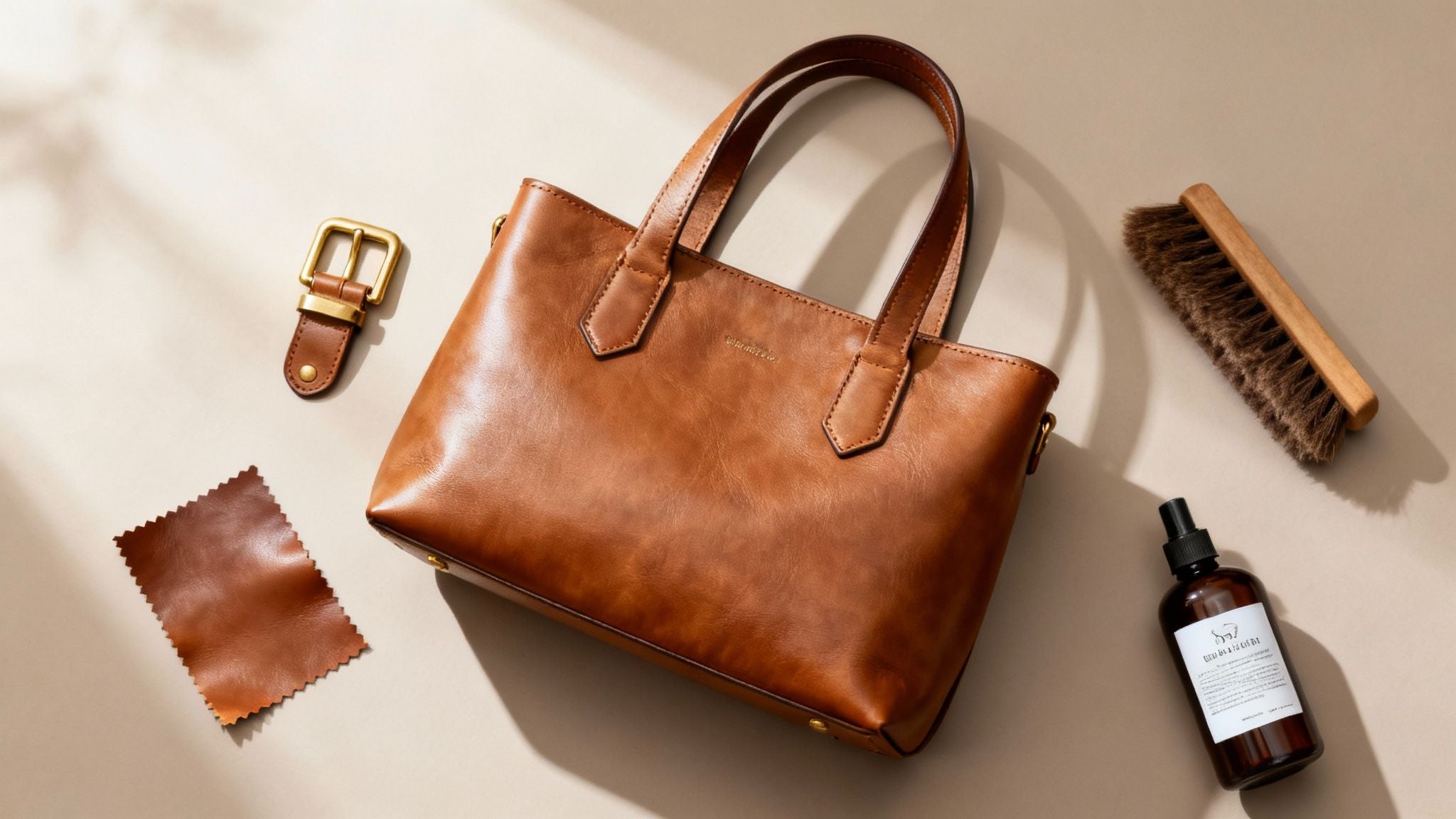
A real leather women's handbag is so much more than just an accessory. It’s a statement of timeless style and a true investment in quality that you'll appreciate for years to come. These bags are beloved for their incredible durability, unique character, and the beautiful way they age, developing a rich patina that tells the story of your life.
Why a Real Leather Handbag Is an Essential Investment
A genuine leather handbag is really the cornerstone of a well-curated wardrobe. It offers a perfect blend of elegance and down-to-earth practicality that synthetic materials just can't match.
Think about it: those mass-produced bags often show serious wear after just one season. A well-crafted leather bag, on the other hand, is built to handle years of daily use. It becomes a reliable companion for work, travel, and everything in between. This kind of longevity makes the initial purchase a smart, cost-effective choice in the long run.
But the appeal goes far beyond just being tough. Real leather has a unique sensory experience that adds so much to its value.
More Than Just a Material
Every piece of authentic leather has its own distinct grain, texture, and natural markings. This means that no two bags are ever exactly alike, giving your accessory a personal touch that truly stands out. Over time, the leather softens, molds to your use, and develops an incredible depth of color. This graceful aging process is something fast-fashion accessories can never hope to achieve.
And let's not forget the smell! Beyond its look and feel, real leather has a distinctive aroma that’s a huge part of its appeal. It's so iconic it has even inspired fragrances that capture the unique green leather scent in niche perfumery.
A Mark of Sophistication and Strength
The global demand for real leather women's handbags proves that people still crave this kind of quality. The industry was valued at around USD 33.29 billion in 2025 and is set to keep growing. This trend shows that savvy consumers continue to prioritize the craftsmanship and lasting value that only genuine leather can offer. You can dive deeper into these trends and see the full report on the leather handbags market.
When you choose a leather bag, you're investing in an item that represents:
- Lasting Durability: It's tough enough to withstand the daily grind.
- Timeless Style: A classic look that never feels dated.
- Personal Character: It develops a unique patina that's all your own.
Understanding Leather Grains and Finishes
Stepping into the world of real leather women's handbags can feel like learning a new language. You hear terms like "full-grain" and "Saffiano" thrown around, but what do they really mean for the bag you carry every day? It’s a lot like shopping for furniture—you instinctively know there’s a massive difference between solid oak and a thin wood veneer, even if they look similar at first glance.
The same idea holds true for leather. The "grain" tells you which layer of the animal hide was used, and that single detail dictates the bag's durability, character, and price tag. Getting a handle on these distinctions is the first real step toward making a smart investment in a bag you'll love for years.
The Hierarchy of Leather Grains
Let's be clear: not all "real leather" is created equal. The quality comes down to which part of the hide is used and how it’s treated. We can break it down into four main types, starting with the absolute best and working our way down.
Comparing Common Leather Grains
To make it simple, here's a quick side-by-side look at the four main leather grains you'll encounter. This should help you quickly grasp the differences in how they look, how they last, and what they'll cost you.
| Leather Grain | Description | Durability | Typical Cost |
|---|---|---|---|
| Full-Grain | The top layer of the hide with all its natural markings and imperfections. The strongest and most authentic type. | Highest | $$$$ |
| Top-Grain | The top layer is sanded or buffed to create a smooth, uniform surface. Flawless appearance. | Very High | $$$ |
| Genuine | Made from the lower layers of the hide. Often corrected with artificial grains and coatings. | Moderate | $$ |
| Bonded | Not a true hide. Made from shredded leather scraps bonded with adhesive onto a backing. | Lowest | $ |
As you can see, the closer you get to the original hide, the better the quality. Now, let's dig into what makes each one unique.
Full-Grain Leather: The Unblemished Original
This is the best of the best, the cream of the crop. Full-grain leather is cut from the very top layer of the hide, and it includes all the natural surface markings—the beautiful, unique imperfections that tell a story. Nothing has been sanded or buffed away.
Because it keeps the densest, strongest fibers of the hide intact, it's incredibly durable. Over time, it develops a stunning patina, that gorgeous sheen that only high-quality leather gets with age. A full-grain leather handbag doesn't just carry your things; it carries a history, with every scuff and mark adding to its unique personality.
Top-Grain Leather: The Polished Performer
Just a step below full-grain is top-grain leather. For this type, the very top layer has been lightly sanded down to remove any imperfections, resulting in a much more uniform and smooth look.
While it's a bit less durable than full-grain (since some of the strongest fibers are altered), it’s still a fantastic, high-quality choice. It's also naturally more resistant to stains, which makes it a really practical option for a bag you plan to use every single day.
Key Takeaway: Full-grain leather is all about natural character and maximum durability, while top-grain offers a flawless, consistent finish with powerful performance. The right choice really comes down to whether you prefer a bag that tells its own story or one that maintains a pristine look.
What About Genuine and Bonded Leather?
Here’s where things get a bit tricky. These terms sound great, but they actually represent the lower tiers of real leather.
- Genuine Leather: This is basically a catch-all term for any leather that isn't good enough to be called full-grain or top-grain. It's usually made from the lower, weaker layers of the hide and is heavily processed—often "corrected" with spray paints and artificial grain patterns to look better than it is. It's far less durable but much more affordable.
- Bonded Leather: This isn't really a leather hide at all. It's the "particle board" of the leather world, made from scraps and leftover leather fibers that are shredded, mixed with polyurethane or latex, and pressed onto a fiber sheet. Bonded leather is the least durable and cheapest option out there, and it's notorious for peeling and cracking over time.
This infographic helps visualize the core qualities that make real leather handbags so special, from their toughness to their undeniable style.
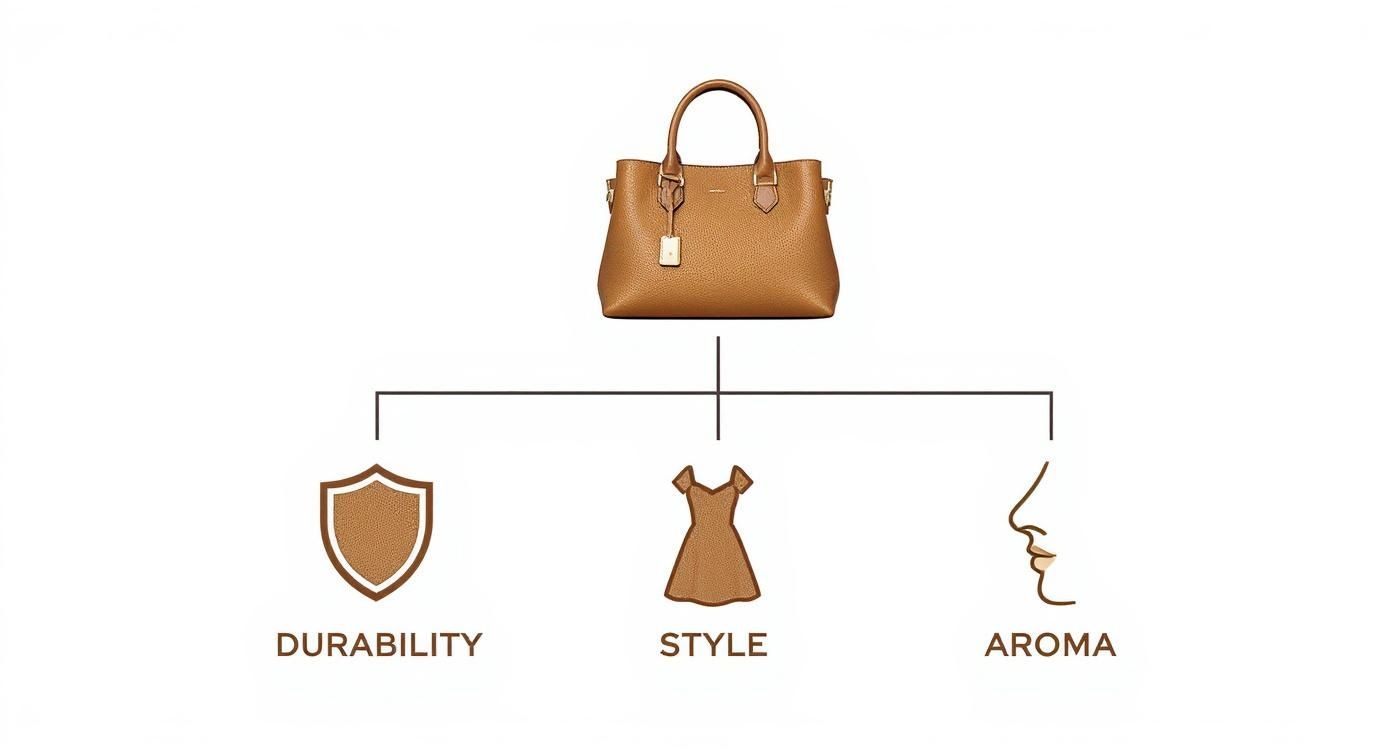
As you can see, the appeal of a great handbag is built on durability, timeless style, and even that unmistakable leather scent—qualities you'll find most prominent in the higher-grade leathers.
From Grain to Gorgeous: A Look at Finishes
Once the grain is sorted, a finish is often applied to create a specific texture, look, and level of protection. The finish can completely transform the leather’s surface, making it just as important as the grain itself. This is especially true for some of the most sought-after styles, like Italian leather, which are defined by their unique tanning and finishing methods. You can dive deeper into the incredible craftsmanship behind what is Italian leather in our detailed guide.
Here are a few of the most popular finishes you'll see on real leather handbags:
Pebbled Leather
This lovely texture is created by tumbling or stamping the hide to create a raised, bumpy surface that looks like tiny pebbles. It’s a fantastic choice for an everyday bag because that textured surface is brilliant at hiding minor scuffs and scratches.
Saffiano Leather
Originally patented by Prada, Saffiano is famous for its signature cross-hatch pattern. This texture is machine-pressed into the leather, which is then sealed with a wax finish. The end result is an incredibly durable, scratch-resistant, and water-resistant surface that’s also a breeze to clean.
Patent Leather
This is any leather that’s been given a super high-gloss, shiny finish. A coating of plastic or lacquer is applied to the surface, making it waterproof and giving it that classic, reflective gleam. It’s a go-to choice for elegant evening bags and formal accessories.
How to Identify a Quality Leather Handbag
Shifting from a casual window shopper to a savvy handbag connoisseur is all about knowing the little secrets of craftsmanship. When you're looking at real leather women's handbags, you’re doing more than just admiring the material. You’re becoming a detective, examining a collection of clues that scream quality. This is your guide to spotting a beautifully made bag that’s built to be by your side for years, not just a season.
The very first, and maybe most primal, test is the smell. Real, genuine leather has a rich, almost earthy aroma that synthetics just can't fake. Faux leather, or "pleather," usually gives off a plasticky or chemical smell. If you're on the fence, just trust your nose. It’s a surprisingly reliable tool for spotting the real deal.
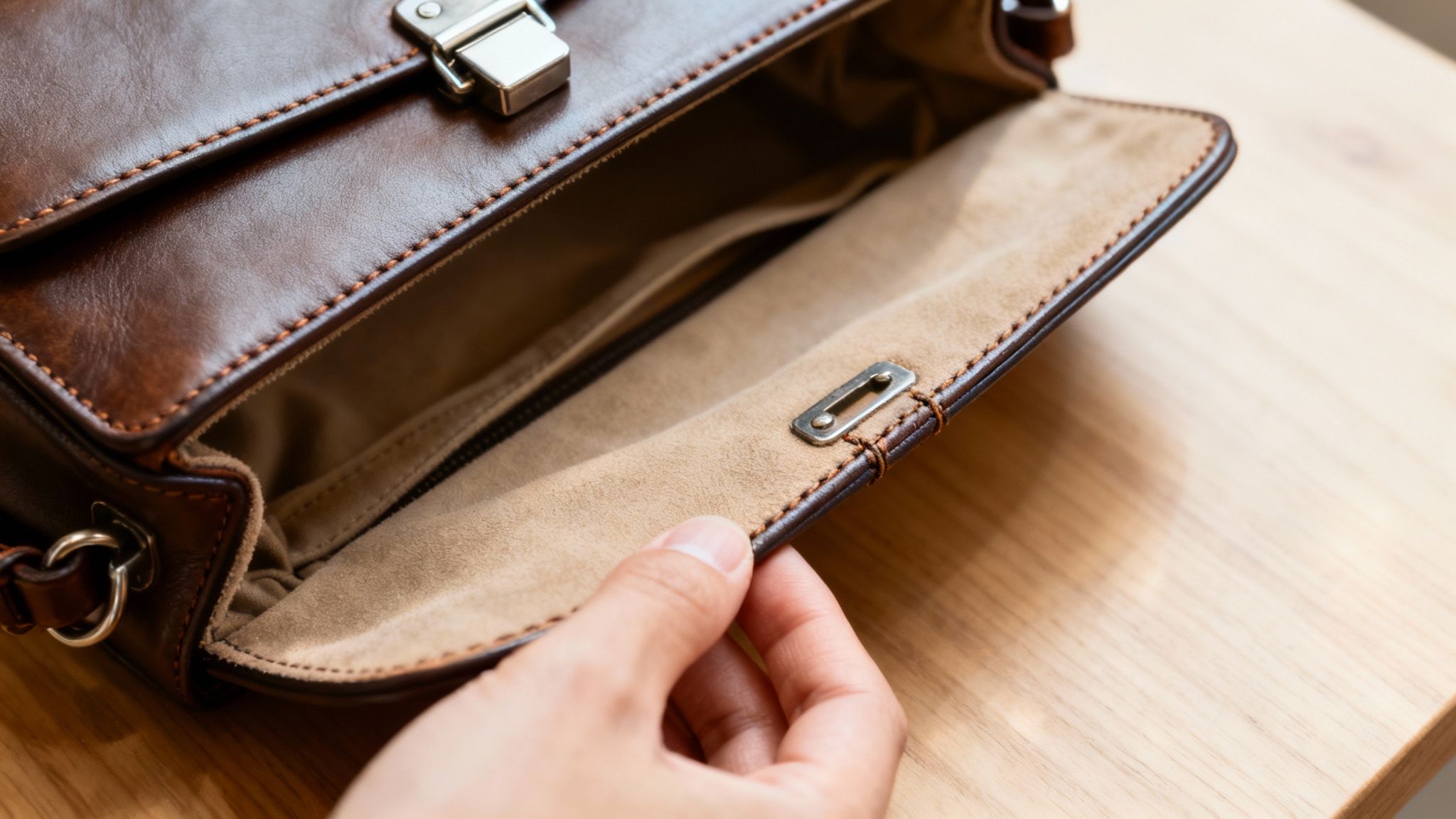
Examine the Stitching and Edges
Now, lean in and take a close look at the stitching. A high-quality handbag will have stitching that is perfectly straight, tight, and consistent. You shouldn't see any loose threads, knots, or wobbly lines. The stitches themselves should be small and uniform—it’s a clear sign that someone took their time and paid attention to the details. Give the seams a gentle tug; they should feel solid and unyielding.
The next thing to check is the edge finishing. On a well-made bag, the raw edges of the leather pieces are sealed with a special paint or glaze. This creates a smooth, clean line that protects the leather from fraying or absorbing moisture. Look for a flawless, even application. On a cheaper bag, you'll often find messy, cracked edges, or even just a raw edge that’s been sloppily folded over and stitched down.
Assess the Hardware and Lining
The hardware—the zippers, clasps, buckles, and feet—is the jewelry of a handbag. On a quality piece, it should feel heavy and substantial in your hand, never flimsy or plasticky. Give the zippers a few test runs; they should glide open and shut effortlessly, without any snagging. Many top-tier makers use zippers from trusted brands like YKK, which is always a good sign.
Don’t forget to peek inside! The lining is an easy place for manufacturers to cut corners, but it says a lot about the bag's overall quality. A great bag will have a durable, neatly fitted lining made from something like canvas, microsuede, or another sturdy fabric. The stitching inside should be just as pristine as it is on the outside.
A common shortcut for lower-quality bags is a cheap, crinkly nylon lining that feels loose or poorly attached. A well-crafted interior shows that the maker didn't cut corners where most people forget to look.
The Feel and Weight Test
Finally, just pick up the bag and get a feel for it. High-quality leather is a paradox: it feels both soft and strong, flexible yet substantial. It will have a natural, almost imperfect texture. Faux leather, on the other hand, often feels a bit cold, stiff, and too uniform. The bag's weight is another clue. Solid metal hardware and thick, durable leather will give it a satisfying heft that signals quality components.
Learning these details really empowers you as a buyer. It's a skill that goes beyond just handbags; you might find value in expert tips on authenticating luxury goods because the principles are the same. It's all about knowing what to look for.
Your Quality Checklist:
- Distinct Smell: Does it smell rich and natural, or like chemicals?
- Consistent Stitching: Are the stitches even, tight, and straight?
- Smooth Edges: Are the edges neatly painted or glazed? No messy, raw finishes.
- Substantial Hardware: Does the metal feel heavy and the zippers run smoothly?
- Durable Lining: Is the fabric inside sturdy and sewn in with care?
Keep this checklist in mind, and you'll be able to confidently pick out a gorgeous leather handbag that isn't just a purchase, but an investment in timeless style.
Essential Care for Your Leather Investment
A beautiful leather handbag isn't just another accessory; it's a companion you invest in. And like any great relationship, it needs a little bit of care to really flourish over time. Think of it less like a chore and more like a simple ritual that keeps your bag looking as stunning as the day you brought it home.
A little bit of maintenance goes a long way. It stops the leather from getting dry and cracked and protects it from unexpected stains, keeping that rich color and soft, supple feel alive for years. It's the difference between a bag that lasts a season and one that tells a story for a lifetime.
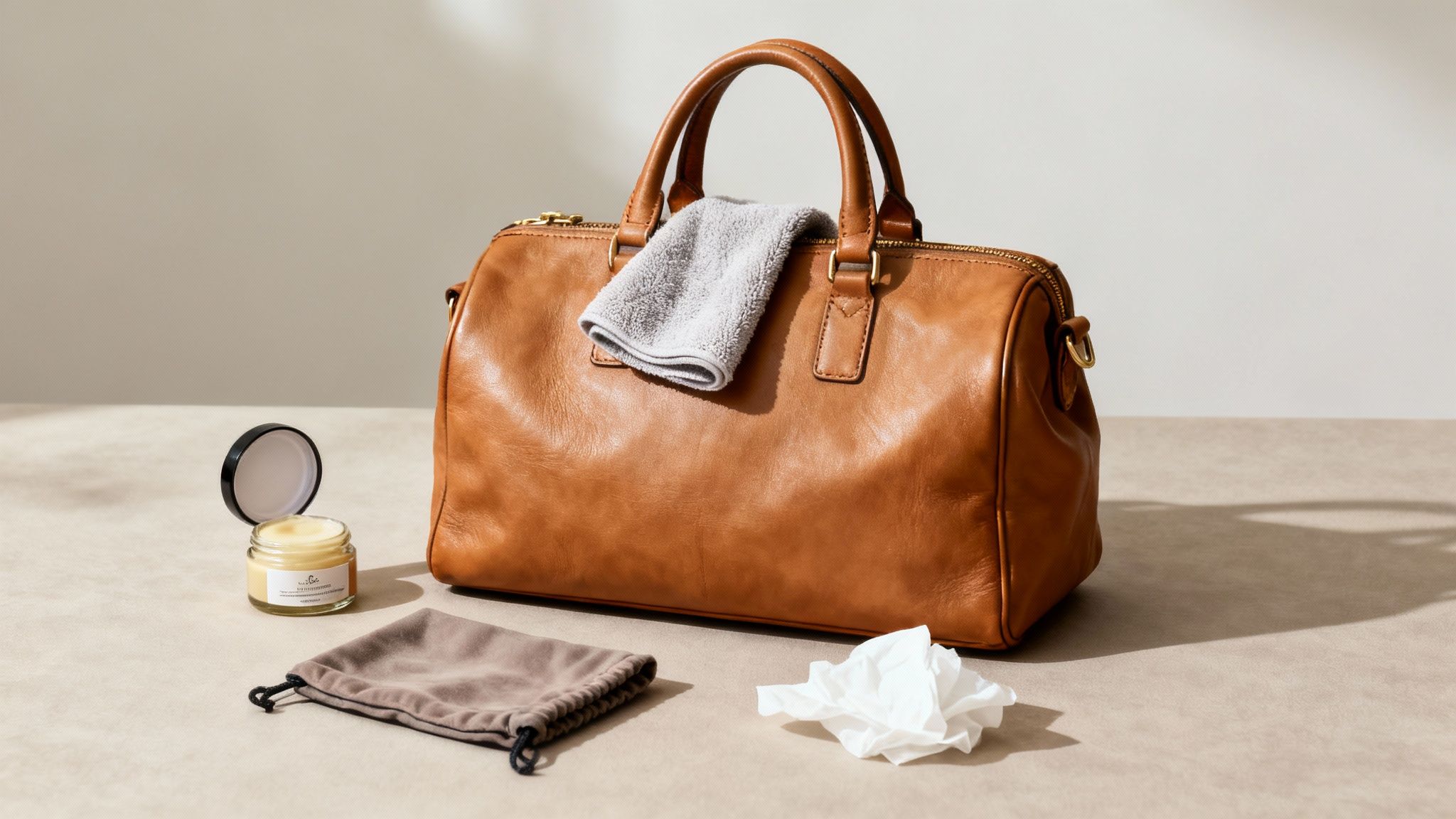
Routine Cleaning and Conditioning
The secret to lasting leather is simple: keep it clean, and keep it moisturized. Over time, dust and dirt can act like fine sandpaper, slowly wearing down the beautiful finish on your bag.
Once a week, just give your bag a quick wipe-down with a soft, dry microfiber cloth. This little step clears away any surface dust before it has a chance to settle in. If you spot a small smudge, a slightly damp cloth is usually all you need to gently lift it away.
But cleaning is only half the story. Leather is a natural skin, and just like our own skin, it can get thirsty.
As a rule of thumb, plan to condition your handbag every 3-6 months. If you live in a drier climate or use your bag daily, you might want to do it a little more often.
A high-quality leather conditioner is like a deep moisturizer for your bag. It restores the natural oils that keep the material pliable and protected. Always remember to test any new product on a small, hidden spot first, just to make sure it doesn't change the leather's color.
Handling Unexpected Spills and Weather
Life happens. From a spilled coffee to a sudden downpour, your bag is bound to encounter the unexpected. The most important thing is to act fast.
If a spill occurs, blot it immediately with a clean, dry cloth. The key is to blot, not rub! Rubbing can spread the stain and push it deeper into the leather. For simple water spots, a gentle blot and some patience are all you need—just let it air dry naturally.
And if you get caught in the rain?
- Empty the bag right away to help it hold its structure.
- Gently pat it dry with a soft towel to soak up excess water.
- Stuff it with paper (plain newsprint or paper towels work great) to absorb moisture from the inside and maintain its shape.
- Let it air dry completely, but keep it away from direct heat like a radiator or hairdryer, which can cause the leather to shrink and crack.
Proper Storage for Longevity
What you do with your bag when you're not carrying it is just as crucial as how you clean it. Simply tossing it into the back of your closet is a recipe for creases, misshaping, and scuffs.
Always store your handbag in its dust bag. This is its best defense against dust, scratches, and the color-fading effects of sunlight. If you misplaced the original, a soft cotton pillowcase is a perfect substitute.
To keep that beautiful silhouette, stuff the bag with something soft, like acid-free tissue paper or even an old scarf. This prevents it from sagging and developing stubborn creases. Finally, give it a home on a shelf where it can stand upright without being squashed. For a deeper dive, check out our full guide on how to care for leather bags.
Choosing a Handbag for Your Lifestyle
Let’s be honest, the perfect real leather women's handbag is so much more than a pretty accessory. It's your daily sidekick, the partner that carries your life and keeps you organized. The real magic happens when you find that sweet spot where gorgeous style meets everyday practicality.
A bag that’s perfect for a powerhouse professional running between meetings probably isn't the one you'd grab for a relaxed weekend brunch. Thinking about your actual, day-to-day life is the first step. Are you a minimalist who just needs a phone and keys, or do you need a bag that can handle a laptop, water bottle, and the kitchen sink? Finding a bag that truly fits your routine is how you make a smart investment.
Matching the Silhouette to Your Routine
Different handbag shapes—or silhouettes—are designed for different jobs. Getting it right is like picking the perfect tool; it just makes everything flow a little smoother. Here’s a look at the most popular styles and who they work best for.
-
The Tote Bag: The undisputed champion of carrying it all. A classic leather tote is a lifesaver for the woman who’s always prepared, easily fitting a 13-inch laptop, documents, or even a change of gym clothes. Its open top means you can grab what you need in a second, making it the ultimate bag for work, travel, or busy moms.
-
The Satchel: A bit more buttoned-up than a tote. Satchels usually have a structured shape with a top handle and a longer crossbody strap. This chameleon-like quality makes it a brilliant choice for the office—it looks polished and professional but is practical enough for the daily commute.
-
The Crossbody: The go-to for the woman on the move. A crossbody’s hands-free design is a game-changer for running errands, navigating a crowded concert, or exploring a new city on vacation. It keeps your essentials safe and right where you need them, without ever slowing you down.
-
The Clutch: The final word in evening elegance. A clutch is all about minimalism, designed to hold just the necessities: your phone, lipstick, and a credit card. It’s that perfect, delicate finishing touch that pulls a formal outfit together.
This need for bags that can do it all has only grown. As more women have entered the professional world, the demand for handbags that are both stylish and versatile has exploded. You can actually explore in-depth market research about leather handbags to see just how much our lifestyles have shaped the industry.
The Power of Color and Versatility
Beyond its shape, a handbag's color is a huge part of what makes it useful. A bright, trendy color can be a fun statement piece, but nothing beats a classic neutral for getting the most wear out of your bag. They just work with everything.
For maximum versatility, your first high-quality leather handbag should be in a timeless, neutral shade. A classic color guarantees your investment will remain stylish and relevant season after season.
Building a Versatile Handbag Collection
Think about starting your collection with a few core, can't-go-wrong colors.
- Classic Black: It’s the ultimate workhorse for a reason. A black leather bag is chic, professional, and looks right with literally everything. It’s a completely foolproof choice that will take you from the boardroom to a dinner date without missing a beat.
- Rich Tan or Cognac: These warm, earthy tones are incredibly chic and surprisingly versatile. A tan bag brings a touch of relaxed elegance to any outfit, looking just as good with jeans as it does with workwear.
- Elegant Navy: A sophisticated alternative to black. Navy has that same classic feel but is a little softer and more unexpected. It’s a beautiful neutral that complements almost any color you pair it with.
Once you have these foundational pieces in your closet, you can have fun branching out. A deep burgundy, a rich forest green, or even a vibrant red can add a gorgeous pop of personality. The goal is to build a small, curated collection where every bag has a purpose, ensuring you always have the perfect accessory ready for whatever life throws your way.
How to Make a Smart Handbag Purchase
Walking into the world of real leather women's handbags can feel a little dizzying. But making a smart purchase really just comes down to one thing: making sure your expectations line up with your budget.
When you understand what you’re getting at different price points, you can invest in a bag you’ll treasure for years, not just for a fleeting season. The goal is to walk away feeling confident, knowledgeable, and excited about the perfect handbag for your life.
A higher price often points to better materials and obsessive craftsmanship. But remember, a bigger price tag isn't always a guarantee of quality, especially when a famous brand name is doing most of the talking.
Setting a Realistic Budget
Before you even start browsing, take a moment to set your budget. This simple step is your best friend—it instantly narrows down your options and keeps you from accidentally falling for a bag that's way out of reach.
Think about what you truly need. Are you looking for a durable, everyday workhorse that can handle your commute, or a stunning special occasion piece you'll only bring out a few times a year?
-
Entry-Level ($100-$300): You can find some incredible bags in this range, especially from independent designers and direct-to-consumer brands. Many use high-quality top-grain leather, and you can even find some full-grain gems. The secret is to look closely at the stitching and hardware—that's where you'll spot a bag that punches well above its price tag.
-
Mid-Range ($300-$800): This is where you start to see established contemporary brands and exciting new designers who are known for their craftsmanship. For this price, you should absolutely expect premium leathers, sturdy linings, and those little design details that make a bag special.
-
Luxury (Over $800): Welcome to the world of heritage luxury houses. Here, you're paying for the power of the brand name, iconic designs that never go out of style, and truly exceptional materials. It's an investment, for sure. If you're weighing the pros and cons, our guide on whether designer bags are worth the investment can help you decide.
Smart Shopping Strategies
With a budget in mind, it's time for the fun part—shopping smart. Don't overlook the pre-owned market! It’s a fantastic way to own a luxury bag at a much friendlier price. Stick to reputable consignment sites that offer authentication services; you'll get peace of mind and make a more sustainable choice.
Pro Tip: Keep an eye out for big sales events like Black Friday or end-of-season clearances. This is the absolute best time to score a high-quality leather handbag, as many brands offer major discounts that make your budget stretch much further.
Finally, always, always check the return policy before you click "buy," particularly when shopping online. A good return window gives you the time to really inspect the bag in person at home. You can make sure the color is right, the size is perfect, and the quality is everything you hoped for. A smart purchase is one you feel completely confident about.
A Few Common Questions About Leather Handbags
Diving into the world of real leather women's handbags can feel a little overwhelming at first. To help you feel completely confident about your next purchase, I've put together answers to some of the questions I hear the most.
How Can I Tell If Leather Is Real?
Honestly, the best way to spot genuine leather is to use your senses. Real leather has that distinct, rich, earthy smell you just can't fake. Faux leather, on the other hand, usually has a chemical or plastic-like odor.
Next, touch it. Real leather feels soft, flexible, and warm, and if you look closely, you'll see a unique grain with tiny, irregular pores. Fake leather tends to feel cold, smooth, and a bit too perfect.
Here’s a simple trick I use: press your finger into the surface. Real leather will wrinkle and gather under the pressure, just like skin. A synthetic material will just indent and pop right back into its original shape. It's those little imperfections that signal true quality.
What Is The Difference Between Full-Grain and Top-Grain Leather?
This is a fantastic question and gets right to the heart of leather quality. It’s one of the most important things to understand.
Think of it like this:
- Full-Grain Leather is the real deal—the absolute best you can get. It's the very top layer of the hide, with all its natural character, markings, and strength left completely intact. It's incredibly durable and develops that gorgeous, sought-after patina as it ages.
- Top-Grain Leather is the next best thing and still a wonderful choice. For this type, the very top surface is sanded down just a bit to remove any imperfections. This gives it a more uniform, polished look and makes it more resistant to stains. It's still incredibly strong and perfect for a daily-use bag.
In a nutshell, you choose full-grain for its rugged, one-of-a-kind character. You choose top-grain for its flawless, polished finish. Both are a brilliant investment when you're looking for real leather women's handbags.
Does Real Leather Get Damaged By Rain?
While a little drizzle isn't going to destroy your bag, leather isn't a fan of getting soaked. If you get caught in the rain, the key is to act quickly to prevent water spots from setting in.
First, gently blot the moisture away with a soft, dry cloth. Whatever you do, don't rub it! That can just push the water deeper into the material.
Once you've blotted the outside, I recommend stuffing the bag with some paper to help it hold its shape and soak up any dampness from the inside. Then, just let it air dry naturally. Keep it away from heat sources like radiators or hairdryers, as intense heat can make the leather shrink and crack. With the right care, your bag can easily handle a little bad weather.
At The Bag Icon, we believe that luxury should be within reach. Explore our collection of beautifully crafted real leather handbags and find the perfect accessory that blends timeless style with everyday function. Discover your next favorite bag at https://www.thebagicon.com.
